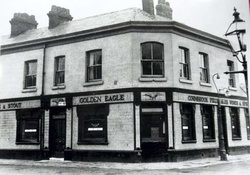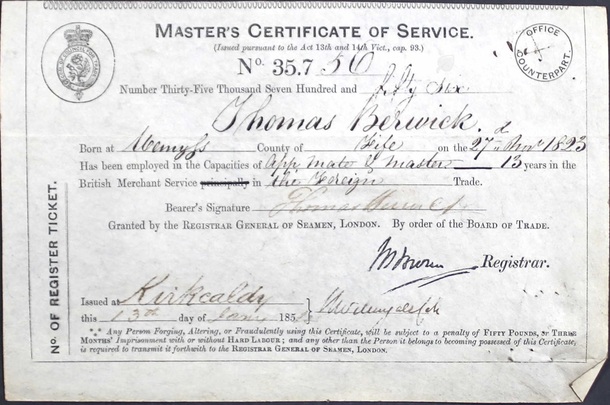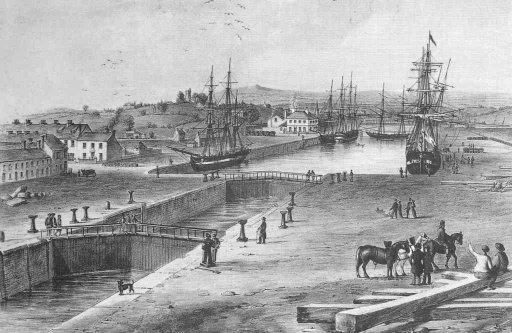IntroductionFamily history research is an ever expanding spider’s web of information full of twists and turns and colourful characters. Those who “got on” in life, those that were less fortunate and those that were downright “wrong ens”. I think secretly we all hope to find our own black sheep, one that maybe hanged for cattle rustling or was transported for stealing a chicken. This month’s blog concerns a couple of such characters I have unearthed in the course of my own research, both related, one by blood, the other by marriage. I promise to keep it as brief as possible, but in order to tell their stories I will need to give you a bit of background. The Herd Family of Montrose & ManchesterRobert Herd my 4x great grandfather was an overseer in a Linen Factory in Montrose when he died in his home in Baltic St on the 10th of December 1855. Together with his wife Jane Eaton they had eight children, five of which survived him. Their eldest son William was the first to venture south to Manchester where after a period of some 15 years as a metal farrier/mechanic he and his wife Hannah Ford moved to the Golden Eagle pub in Birmingham St, Manchester in the 1850’s. The pub would have experienced a brisk trade as not only did it serve London Road train station but was also adjacent to the busy London Road market. Following William’s death in 1872, Hannah moved to another pub of the same name, in Lodge Street, Miles Platting, Manchester where she appeared as landlady in Slater’s Directory of 1879 before she passed away in 1880. Meanwhile back in Montrose, William’s sister Jessie had married George Ruxton a baker there in 1836. In 1850 they too had made the journey south to Liverpool with their six children. William Herd and Hannah Ford had ten children, the eldest Robert (my 2x gt grandfather) was born in Chorlton Hulme, Manchester on 17th December 1837. Despite his humble beginnings and scratchy start as a fish salesman, he would go on to enjoy a successful career as a calico printer. The same however cannot be said for his younger brother Edward William! Edward William HerdEdward William Herd was born on 22nd November 1844 and followed his father’s original occupation of mechanic and appears as an engine turner in the census as an unmarried boarder in Stockton in 1871. Edward then disappears from the radar but must have at some point decided as a single man he would try his luck in Australia, as the next we hear of him he has been apprehended by the police in New South Wales!
The husband of Edward’s cousin Jeanie Ruxton had made the voyage 8 years earlier under entirely different circumstances – transportation, and 20 years penal servitude for fraud that proved to be a truly family affair and of epic proportions! Re-enter the Ruxton family. Following Jessie (nee Herd) and husband George Ruxton’s move south to Liverpool in 1850, George established himself as a baker supplying bread for merchant ships. According to the census returns they must have enjoyed a relatively close relationship with the Herd family of the Golden Eagle. In 1856 their eldest daughter Jane or Jeanie married a certain Thomas Berwick, ship owner and Master Mariner from Scotland. Thomas BerwickThomas Berwick was born in Fife in November 1823 to parents Thomas Berwick and Jane McDonald. From the death and probate records of his father Thomas senior in 1857 it appears he was a third generation Ship Master and had been in partnership with his father running merchant vessels out of Kirkcaldy prior to that gentleman’s demise. After his marriage he and his wife Jeanie Ruxton set up home at 25 The Willows, Everton. Thomas eventually fell afoul of the law in Nov 1866 when he and his accomplices were arrested for deliberately scuttling his own ship the “Severn” in an attempt to defraud its insurers. A lengthy trial followed which would prove this incident to be but the tip of the iceberg. In all, details of no less than 15 similar incidents dating back as far as 1844 concerning ships in the ownership or part ownership of Thomas Berwick were put before the judge. In many cases his main partner in crime was Lionel Holdsworth, a ship broker, but other names noted were his father Thomas Berwick, his mother Jean Berwick, and in 1862 his father in law George Ruxton was arrested and tried for deliberately setting fire to the “Kate Kearney”. With a warrant out for his arrest in the same case Thomas evaded the law by absconding to France. His father in law George Ruxton was acquitted of the crime due to lack of evidence. The scuttling of the Severn was a “deed elaborately contrived”. The ship had been purchased early in 1866 by Berwick in a deal brokered by Holdsworth and his agent one Mr Dean said to be worth approximately £4,000. Essentially very little money changed hands as the vendor believed Berwick to be in funds from his underwriters for the ship the “Joan Brown” lost the previous year, and took promissory notes in good faith. The ship was sent to Newport, with another long standing accomplice a Mr Webb as First Mate, to be loaded with coals bound for Shanghai, the cargo was valued at approximately £3,000. But how to insure it? Berwick’s reputation for ‘losing’ ships was such amongst underwriters it would have been impossible to obtain in his own name. The solution was to pay a Mr Ward, a wine merchant £50 to sign a document claiming ownership of the vessel. By the time the ship left Newport dock it was insured by several underwriters to a value of approaching £15,000. Not content with this, Holdsworth and Berwick paid the ship’s Captain a further £10 to convey a number of packing cases stated to contain carbines, revolvers and swords within his own cabin. The contents of these cases were insured for a further £1,500. It was later proved that these cases contained nothing more than £4 of salt! These dastardly criminals may have been successful had it not been for the evidence of the crew, who from the life boats clearly saw the newly drilled holes with the splinters pointing outwards in the ships stern as, with the aid of a rough sea, she actually sank by the head! The crew members also commented on the unusual amount of time and expense bestowed upon the lifeboats prior to departure! Their trial lasted five days, was covered extensively in the press and caused quite a sensation. The total punishment meted out was 55 years penal servitude with transportation, 20 years each for Berwick and Holdsworth, 10 years for Webb the 1st Mate and ships carpenter, and 5 years for a Mr Dean, under agent to Mr Holdsworth. In summing up the case Judge Blackburn referred to the prisoners as :- “a certain class of vermin objecting to the small-tooth comb” Thomas Berwick and Lionel Holdsworth both left to serve their sentences in Australia on the 30th September 1867 aboard the Blackwall Frigate “The Hougoument”. The ship docked in Freemantle, Western Australia on the 9th January 1868, marking the end of convict transportation to the colonies.  Golden Eagle in Miles Platting, Manchester Golden Eagle in Miles Platting, Manchester I would like to add that apart from these rather unscrupulous individuals the Herd family and indeed the descendants of Thomas Berwick so far as I a can ascertain were decent law abiding folks. The photograph on the left is the Golden Eagle in Lodge St, Miles Platting, Manchester where Hannah Herd was landlady in 1879. It was also home to the celebrated author and composer Anthony Burgess from circa 1922 - 1928, amongst whose best known works was "A Clockwork Orange". http://www.anthonyburgess.org/about-anthony-burgess/burgess-a-brief-life  Aside from being aboard the last convict ship, the journey was also remarkable for the number (62 of 280) of literate political prisoners on board. These were members of the Irish Republican Brotherhood convicted of treason for taking part in the Fenian Rising of 1867. Whilst on board they even produced their own newspaper “The Wild Goose”. It sounds like the voyage would have been far from boring. A full list of the convicts aboard together with a physical description can be found below. Thomas Berwick is described as a married man aged 43 with seven children. 5’ 7” in height with brown hair and hazel eyes. Face = Round, Complexion = Fresh, Build = Stout. Distinguishing marks = Mole on right eye, Scar to right arm. Holdsworth on the other hand at 6’ was one of the tallest men aboard, 40 years old and married but with no children. http://members.iinet.net.au/~perthdps/convicts/conwad42.htm Thomas received his “Ticket of Leave” in 1878:- “Ticket-of-leave men were permitted to marry, or to bring their families from Britain, and to acquire property, but they were not permitted to carry firearms or board a ship, and they were often restricted to a specific district stipulated on the ticket. They were often required to repay the cost of their passage to the colony” (Thankfully he was not permitted to board a ship!) At that time in 1878 he was working as an unofficial school teacher in Jarrahdale, and the following year he was officially appointed to the post of Government Schoolmaster. In 1882 Thomas bought a tract of land and built a large house in the hope that his family would join him from England. Alas for Thomas this did not come about, his wife had died in 1880 and the children in the 1881 census are living together with his eldest son Thomas head of the household, occupation ironically “Calico Printer’s Salesman”. As a result Berwick rented the house to a local innkeeper and continued to teach until he died in his bed in Jarrahdale in 1891. ConclusionThomas Berwick was one of the very few convicts to overcome the social stigma and gain a respectable position within society. Indeed he was one of only 37 of 9721 convicts transported to the colonies to become a school teacher. However, despite this to spend 23 years without his family, and their refusal to join him, must have caused a deep rooted sadness in his life.
Much has been written about the case of the scuttling of the Severn with an account of the court proceedings appearing the Nautical Magasine 1871 commencing on page 223, and many press commentaries are available online at The British Newspaper Archive
9 Comments
Michael Oliver
28/1/2015 12:05:46 pm
As always, a great read so many thanks.
Reply
Odette Venuti
28/1/2015 12:34:44 pm
Lots of details and information. You're good, Susie!
Reply
Jeremy Smith
28/1/2015 01:25:21 pm
A Very interesting read even though slightly concerning that insurance fraud runs in the family - particularly as I am a director of an insurance brokers (Don't worry we don't deal in shipping!)
Reply
Heather CullingSmith
28/1/2015 02:36:05 pm
Always very interesting and fascinating to find the vermin that embarras the.family.
Reply
3/2/2015 11:34:36 am
Another great read. A great friend of my is called Herd! Must remember to send her a link to read this blog.
Reply
Philip Barnes
17/8/2015 09:20:34 am
As the great great grandson of Thomas Berwick, currently working on his daughters' marriages to two Mancunian brothers named Gray, this is an invaluable resource. Thank you so much for making this available. Have you followed Thomas's career once he landed in Western Australia? He became one of only 37 ex-convicts to be appointed a schoolmaster, and is credited with the gradual erosion of the social stigma of 'convictism'. There's a whole wikipedia article on his life in Australia.
Reply
Susie Douglas
17/8/2015 10:15:27 am
Hi Philip
Reply
Philip Barnes
28/8/2016 10:11:20 pm
Sorry it's been a year since I wrote, but I have at last finished the first edition of the GRAY family history, and this incorporates much of your excellent work on Thomas Berwick. I'd be happy to send you my re-working of your account, asking you to see if I'm veered from the truth anywhere! Please let me know. I might add that our suppositions that Thomas Berwick's family 'refused' to join him in Australia might not be wholly accurate. His invitation would have come at a very difficult time for the family, engaged as they were with many other developments. I suspect instead that they simply couldn't see how they could leave the UK.
Robert Dornan
4/9/2016 11:29:10 pm
My lineage - William Herd (1851-1918), Robert Alfred Herd (1885-1960), Doris Herd (1914-1989) my mother. Thanks for filling in details about very early Herd's. I had not been able to prove William went from Montrose to Manchester. How did you prove this? I have a lot of documents for them on my ancestry.com page.
Reply
Leave a Reply. |
AuthorSusie Douglas Archives
August 2022
Categories |
Copyright © 2013 Borders Ancestry
Borders Ancestry is registered with the Information Commissioner's Office No ZA226102 https://ico.org.uk. Read our Privacy Policy










